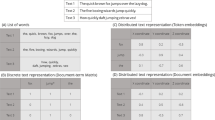Abstract
This paper examines some textual devices that writers may use to pre-structure the activities of their readers. HyperText Markup Language (HTML) is used as an 'explicating device' to explore how writers can provide reading instructions, and how these can be experienced by readers. Structuring devices like paragraphs and sections, and hypertextual elements like notes and references are investigated in detail. In this way, the paper aspires to contribute to 'an ethnomethodology of textual practices'
Similar content being viewed by others
References
Anderson, D.C. (1978). Some organizational features in the local production of a plausible text, Philosophy of the social sciences 8: 113-135.
Atkinson, J.M. (1983). Two devices for generating audience approval: a comparative study of public discourse and texts. In K. Ehlich and H. van Riemsdijk, (Eds.), Connectedness in sentence, discourse and text, pp. 199-236. Tilburg: Katholieke Hogeschool Tilburg.
Becker, H.S., with P. Richards (1986). Writing for social scientists: How to start and finish your thesis, book, or article. Chicago: University of Chicago Press
Benschop, A. (1997). Lineaire en Hypertekst [Linear and hypertext; in Dutch only], online only at http://www.pscw.uva.nl/sociosite/HyperText.html.
Garfinkel, H. (1967). Studies in ethnomethodology. Englewood Cliffs, N.J.: Prentice Hall
Garfinkel, H. and Sacks, H (1970). On formal structures of practical action. In J.C. McKinney and E.A. Tiryakian, (Eds.), Theoretical sociology: perspectives and developments, pp. 338-366. New York: Appleton-Century-Crofts.
Garfinkel, H. and Wieder, D.L. (1992). Two incommensurable, asymmetrically alternate technologies of social analysis. In G. Watson, R.M. Seiler, (Eds.), Text in context: studies in ethnomethodology, pp. 175-206. Newbury Park, etc. Sage.
Gilbert, N. (1993). Writing about social research. In: Gilbert, N. (Ed.), Researching social life, pp. 328-344. London: Sage.
Have, P. ten (1990). Methodological issues in conversation analysis, Bulletin de Méthodologie Sociologique, Nr. 27 (June): 23-51 (also at: http://www.pscw.uva.nl/emca/mica.htm)
Heslop, B. and Budnick L. (1995). HTML Publishing on the Internet, for Windows. Chapel Hill, NC: Ventana.
Lemay, L. (1997). Teach yourself web publishing with HTML 3.2 in 14 days. Second professional reference edition. Indianapolis: Sams.net Publishing.
Landow, G.P. (1992). Hypertext: The convergence of contemporary critical theory and technology. Baltimore: The Johns Hopkins University Press. [cited in McHoul and Roe (1996)].
Lynch, M. (1985). Art and artifact in laboratory science: a study of shop work and shop talk. London: Routledge & Kegan Paul.
McHoul, A.W. (1982). Telling how texts talk: essays on reading and ethnomethodology. London: Routledge & Kegan Paul.
McHoul, A. and Roe, P. (1996). Hypertext and reading cognition. In B. Gorayska and J.L. Mey (Eds.), Cognitive Technology: In search of a humane interface. Elsevier: 347-59 (also: http://kali.murdoch.edu.au/~cntinuum/VID/cognition.html).
Mehan, H. and Wood, H. (1975). The reality of ethnomethodology. New York: Wiley.
Morrison, K. (1981). Some properties of “Telling Order Designs” in didactic inquiry, Philosophy of the Social Sciences 11: 245-262.
Pollner, M. (1979). Explicative transaction: making and managing meaning in traffic court. In G. Psathas (Ed.), Everyday language: studies in ethnomethodology. pp. 229-255, New York: Irvington.
Rodino, M. (1997). Breaking out of binaries: Reconceptualizing gender and its relationship to language. In Computer-Mediated Communication (http://jcmc.huji.ac.il/vol3/issue3/ rodino.html.), Journal of Computer-Mediated Communication (http://shum.huji.ac.il/ jcmc/) 3(3).
Sacks, H., Schegloff, E.A. and Jefferson, G. (1978). A simplest systematics for the organization of turn taking for conversation. In J.N. Schenkein, (Ed.), Studies in the organization of conversational interaction,. New York: Academic Press: 755 (1974)
Schegloff, E.A. (1996). Turn organization: one intersection of grammar and interaction. In E. Ochs, E.A. Schegloff and S.A. Thompson, (Eds.), Interaction and Grammar. pp. 52-133, Cambridge: Cambridge University Press.
Schegloff, E.A. and Sacks, H. (1973). Opening up closings, Semiotica 8: 289-327.
Schwartz, H.and Jacobs, J. (1979). Qualitative sociology: a method to the madness. New York: Free Press.
Suchman, L. (1987). Plans and situated action: the problem of human-machine communication. Cambridge: Cambridge University Press.
Sudnow, D. (1978). Ways of the hand: the organization of improvised conduct. London: Routledge & Kegan Paul.
Tauscher, L. and Greenberg S. (1997). How people revisit web pages: empirical findings and implications for the design of history systems (online only at: http://ijhcs.open.ac.uk/ tauscher/tauscher.html).
Wieder, D.L. (1974). Language and social reality: the case of telling the convict code. The Hague: Mouton.
Zimmerman, D.H. (1969). Record-keeping and the intake process in a public welfare agency. In: S. Wheeler, (Ed.), On record: files and dossiers in American life. pp. 319-345, New York: Russell Sage.
Author information
Authors and Affiliations
Rights and permissions
About this article
Cite this article
ten Have, P. Structuring Writing for Reading: Hypertext and the Reading Body. Human Studies 22, 273–298 (1999). https://doi.org/10.1023/A:1005496619385
Published:
Issue Date:
DOI: https://doi.org/10.1023/A:1005496619385




